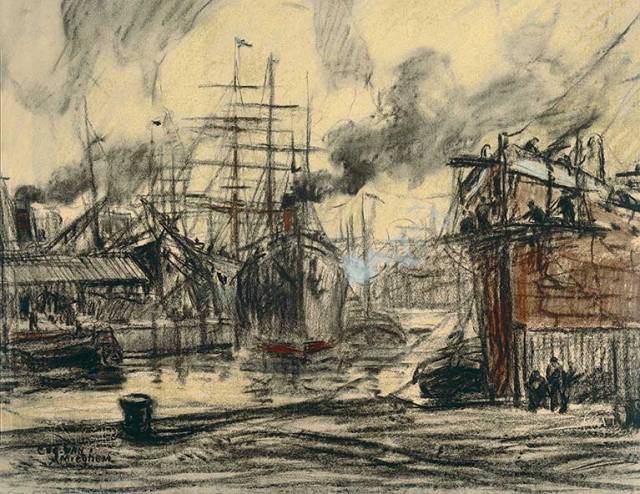The works of the acclaimed Belgian artist Eugeen Van Mieghem will go on display to Irish audiences for the first time this week, when a major new exhibition opens at Dublin City Gallery The Hugh Lane on Thursday, 9th February 2017. Supported by Dublin Port Company as part of its Port Perspectives arts commissioning series, the exhibition “Eugeen Van Mieghem: Port Life” provides a fascinating visual account of the pulsating life of the Port of Antwerp at the turn of the 20th century.
Featuring more than 70 paintings, drawings and prints, this unique body of work provides a social history, depicting the life of the artist and exploring themes of migration, globalisation, and the working port community – themes that resonate with Dublin as a port city in Europe today.
In this series of works, Van Mieghem illustrates the harsh labour conditions of dockers, porters and sack-sewers at the time of mechanisation, empathises with the plight of refugees under German occupation, observes the colourful characters that frequented his parents’ quayside café/tavern, and documents the social life of the city including the elegant cafés of Belle Époque society and promenades along the Scheldt. The artist’s personal life is also revealed through drawings and paintings documenting his first wife, who became ill with tuberculosis and died at the age of just 24.
In keeping with Dublin Port’s commitment to port-city integration, the exhibition includes a special programme of events designed by The Hugh Lane to bring Van Mieghem to a wider audience. A series of public lectures and ‘coffee conversations’ will take place at the gallery during the exhibition, which runs until 11th June 2017. The first is a Public Lecture on the life of the artist by Erwin Joos, Director, Eugeen Van Mieghem Museum, Antwerp (5.30pm, Thursday 9th February – Free).
There will also be artist-led workshops, Sunday sketching sessions and guided tours for younger audiences. The first is a mid-term workshop for 6-10 year olds with artist Liliane Puthod to include a guided tour of the exhibition and print workshop that considers port life in Dublin City (11am – 1pm on Friday, 24th February - €10).
For further information, bookings and enquiries: www.hughlane.ie / 01 222 5550.
Michael Dempsey, Head of Exhibitions, Dublin City Gallery The Hugh Lane, said: “Van Mieghem aligned himself with the Impressionists, who painted subjects which had previously been considered unworthy of representation.”
Director of the Gallery, Barbara Dawson, said: “Van Mieghem’s affinity with his subjects makes his work direct and sincere and is unique in the genre of social realism.”
Eamonn O’Reilly, Chief Executive, Dublin Port Company, said: “Dublin Port is delighted to be the main sponsor for this exhibition and see the works of Van Mieghem in Ireland for the first time. His is one of the few visual histories of port life in 20th century Europe, illuminating and recording the strong ties that existed between Antwerp’s port, city and people. The historical and cultural links between ports and cities have been lost over time, and Dublin Port is now focused on developing these bonds again. I hope that people will take this opportunity to see the works of Van Mieghem at The Hugh Lane, connect with his works and with Dublin as a vibrant port city.”






























































